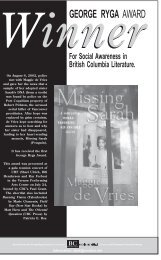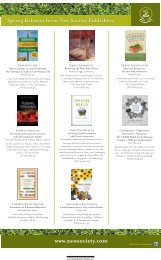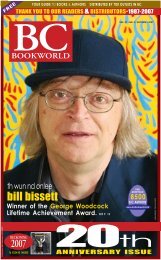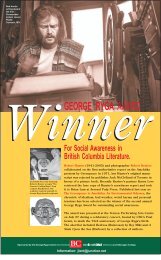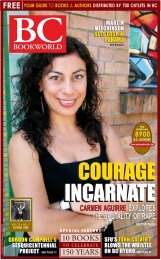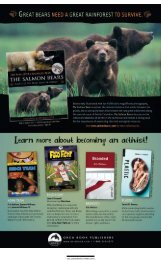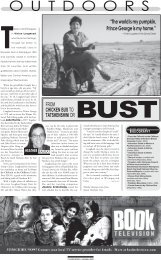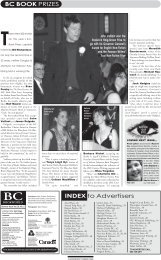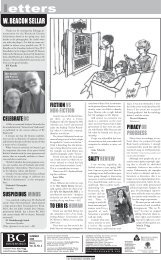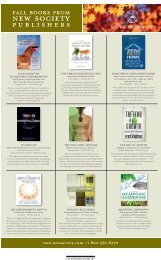Spring 2008 Volume 22 - No. 1 - BC BookWorld
Spring 2008 Volume 22 - No. 1 - BC BookWorld
Spring 2008 Volume 22 - No. 1 - BC BookWorld
- No tags were found...
Create successful ePaper yourself
Turn your PDF publications into a flip-book with our unique Google optimized e-Paper software.
REMEMBERING JANE RULEISLAND OF THEHEARTlearned to swim in her backyard pool where sheand her partner Helen Sonthoff were dotinglifeguards with a great supply of pop-up books.✍Jane Rule was also one of the first writers I everor six decades, interviewed. I first met her thirty years ago whenTalonbooks publishers David Robinson andJane Vance “Jinx” Rule wasKarl Siegler reprinted her non-erotic loveone of the most mature, story, Desert of the Heart. She was the funniest andsanest person I had ever met.humourous and responsible Nine years later, after we started <strong>BC</strong><strong>BookWorld</strong>, Rule agreed to be one of three writerson the board of directors for Pacific <strong>BookWorld</strong>voices in Canadian letters, and forftotwenty years she was a close friend News Society. [The others were Howardthis publication.White and George Woodcock.]Jane Rule received the second Terasen LifetimeAchievement Award for an Outstanding LiteraryAlthough she is admired for her Career in British Columbia in 1996. She wasJane Rule groundbreaking 1964 novel Desert of the Heart, awarded the Order of British Columbia in 1998BIBLIOGRAPHY: in which two women fall in love in Reno, Nevada, and the Order of Canada in 2006.Jane Rule was long concerned with issues of truth Her reputation continues to grow.and freedom beyond the realms of sexuality. Profiles✍invariably begin by mentioning her six-foot-Born in New Jersey on March 28, 1931, Janeframe and her husky voice, but she was much more Rule was the middle child and oldest daughter ofthan a human lighthouse signalling the way for Carlotta Jane (Hink) and Arthurincreased tolerance and self-acceptance.Richards Rule, a free-thinker who graduatedA vibrant conversationalist who loved to laugh, from the naval academy at Annapolis and rose todrink and smoke, she was revered in the Gulf Islandsthe rank of lieutenant-commander during Worldas ‘the Bank of Galiano’ because she pro-War II. His favourite expression was, “I’d rathervided low interest loans to the disadvantaged. be right than president.”Equally important, literally dozens of youngsters She passed her first four years at Wynchwood,FICTION:Desert of the Heart(Macmillan, 1964)This Is <strong>No</strong>t For You(Naiad Press, 1970)Against the Season(Doubleday, 1971)Theme for DiverseInstruments(Talonbooks, 1975)The Young In OneAnother's Arms(Naiad, 1977)Contract With The World(Naiad, 1980)Middle Children,Short stories (Naiad, 1981)Outlander, Stories andessays (Naiad, 1981).Inland Passage(Lester & Orpen Dennys, 1985)Memory Board(Macmillan, 1987)After the Fire(Naiad, 1989)NON-FICTION:Lesbian Images(Doubleday, 1975)A Hot-Eyed Moderate(Lester & Orpen Dennys, 1985)Detained at Customs:Jane Rule Testifies at theLittle Sister's Trial(Lazara Press, 1995)NEW:Jane Rule’s essaycollection,Loving the Difficult(Hedgerow Press $21.95)will be launched at Heritage Hallin Vancouver on April 26 andon May 3 at the communityhall on Galiano Island.978-0-9736882-6-9DAVID ROBINSON PHOTOJane Rule with Alan Twigg at Montague Harbour, Galiano Island, 1978a family farm in New Jersey where her paternalgrandfather built a replica of Robbie Burns’cottage and filled it with children’s books. Afterthe family moved to California, she spent summerson a remote, 240-acre ranch among the redwoodsthat belonged to her mother’s parents. InCalifornia, her best friends were Chinese and JapaneseAmerican children, and she was baffled bythe concept of racism.From a tender age, Jane Rule was notoriouslyrebellious against authority figures, particularlyteachers. She and her beloved older brother Artchanged schools constantly, as much as three timesper year. In one class of 14 girls, there were fiveJanes so she willingly adopted her nickname Jinxand it stuck ever after. At age ten, her myopia wascorrected by glasses but her family moved frequentlyand she was hampered by dyslexia. Sixfeettall at age 12 and unaccomplished atschoolwork, Rule was strongly supported by herparents who accepted her non-conformist tendencies.If her teacher complained that she hadfallen asleep in German class again, her motherwould calmly reply, “Well, you're boring heragain.” By age 15 Jane Rule decided she ought tobe a writer. “I felt that most of the books I wasreading were lies,” she later recalled. “I was morallysuperior and quite obnoxious. That set meagainst the monstrous patriotic stupidity that waseverywhere, the lack of trust, the sense of hatredand the false discipline.”That same year she was expelled, five monthsshort of graduation, for an article she wrote inher school paper protesting the allocation ofschool funds for ‘charm school’ classes. In particular,Rule took objection to beingshown how to walk.When the instructortold the class toimitate her, Ruledid—cheekily—and was tossed fromthe class. Consequentlyshe wrote an article expressingher opinionthat girls should betaught how to walk to thenearest college. The principalexpelled her for insubordination.Her reputation asa ‘moral hazard’ would make it difficultfor her to gain acceptance tocollege.Also at age 15, Jane Rule’s outsiderismincreased when she read Radclyffe Hall'sThe Well of Loneliness. Although she began to recognizeher own lesbian nature, her enthusiasmfor the once-banned novel was hesitant, at best.“It was a polemic by a famous English lesbianpleading for an understanding of homosexualsand lesbians, whom it described as men trappedin women’s bodies!” Rule recalled. “It was a verybrave book but also a very bad book. The maincharacter was six feet tall and had a deepvoice. I thought, ‘That can’t be who I am!Will I have to live in some ghetto in Parisand be a freak?’ It was such a scarything.” Rule later describedRadclyffe as “about the biggestmale chauvinist pig you couldfind. Gradually Rule developeda theory that one chiefly makesprogress by learning from thebad examples of others. “I wasfive before I discovered thatbeing a girl had seriousdrawbacks, six before I discoveredbeing left-handedwas unacceptable andnineteen and travelling inEurope for the first timebefore I had to apologizefor being an American,”she later wrote. In the1960s she became “proud and relieved to claimthe label Canadian.”At 16, her first sexual experience was a lesbianrelationship, but given her moralistic upbringingand the forbidding climate forhomosexuality in the early 1950s, she says she remainedcelibate during her attendance at MillsCollege, a posh women’s school in Oakland. Shehad wanted to study English at Stanford but shewas repeatedly rejected by numerous schools untila trustee at Mills College enabled her to be enrolledon a probationary basis. Because her testresults were higher in science and math, she wasinitially not allowed to major in English. Eventuallyshe got her way,but the head ofthe Englishdepartment warned her about pursuing a literarycareer, telling her she could either become afirst-rate scholar or a third-rate writer. Rule repliedthat she much preferred the latter. Rule subsequentlysent that discouraging professor everybook she published and dedicated a book to her.“I guess I'm still not a very nice person,” she oncenoted.After she received a bachelor’s degree in Englishfrom Mills in 1952, Rule began working onher first novel when she was living in Englandand taking some classes at University College, London.Having gone to England to pursue a relationshipwith a female lover, she nonethelessbecame friends with JohnHulcoop, a doctoral candidateat UC who later accepted ateaching job with the Englishfaculty at the Universityof BritishColumbia. Returningtothe UnitedStates, Jane Rule was soon disenchanted with thecompetitive and demeaning atmosphere of writingclasses at Stanford University. When she optedfor a teaching job with a private school for girlsin Massachusetts, Concord Academy, she fell inlove with Helen Sonthoff, a creative writing instructorwho was married to HerbertSonthoff, a German who had fled the Naziregime during World War II.McCarthyism was rampantin the United States and extramaritallesbian relationshipswere simply not to be tolerated,so Jane Rule moved to Vancouverin the fall of 1956, takingrefuge in a four-room flatrented by John Hulcoop. Accordingto Sandra Martin’sobituary of Rule for TheGlobe & Mail, Hulcoop andRule briefly became lovers. Atage 40, Helen Sonthoff cameto Vancouver to visit Rule, atJane Ruleage 25, and they resumed theirintimate relationship. Theywould remain living as a coupleuntil Helen Sonthoff died in 2000, at age83. Rule was deeply disheartened by her partner'sdeath, as she had been when her father diedat age 88 in 1994.While Helen Sonthoff gained a foothold inthe U<strong>BC</strong> English department as a teaching assistant,Rule pursued her fledgling writing career,read scripts and became the assistant directorat the university’s new International House forforeign students. Even though Rule had only abachelor’s degree, she also intermittently taughtlower-level English courses at U<strong>BC</strong> until 1976when she and Sonthoff relocated to Galiano Islandon a permanent basis. “I arranged my lifeso that I taught every other year at U<strong>BC</strong>,” Rulesaid. “It took 25 years to get there as a full-timewriter.” She stopped teaching at age 43. Shesometimes said she came out as a lesbian long beforeshe came out as a writer.continued on next page“I am not awriter who sitsdown to discoverwhat I think.”— JANE RULE, 2004<strong>22</strong> <strong>BC</strong> BOOKWORLD • LOOKOUT • SPRING • <strong>2008</strong> 23 <strong>BC</strong> BOOKWORLD • LOOKOUT • SPRING • <strong>2008</strong>



